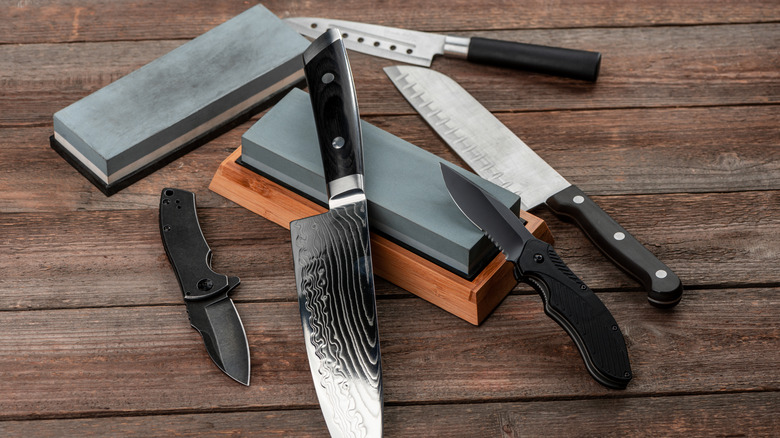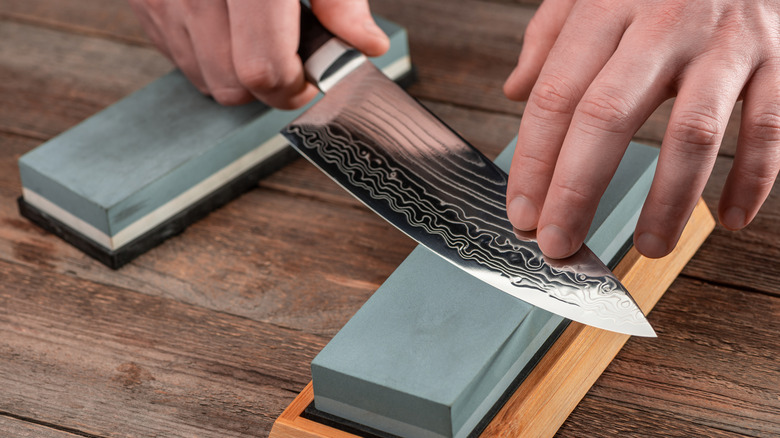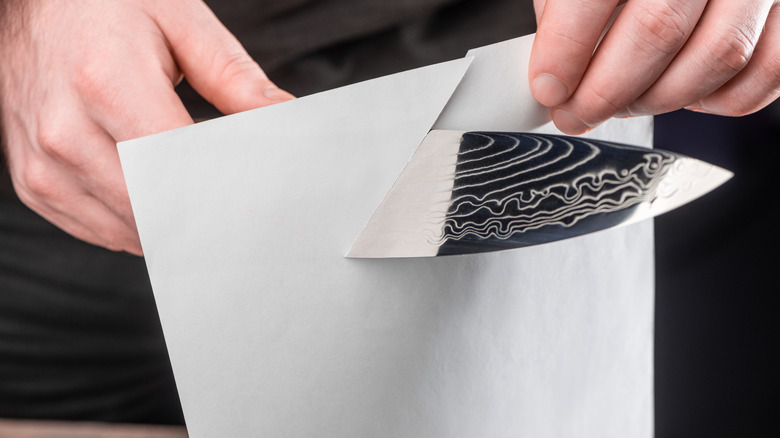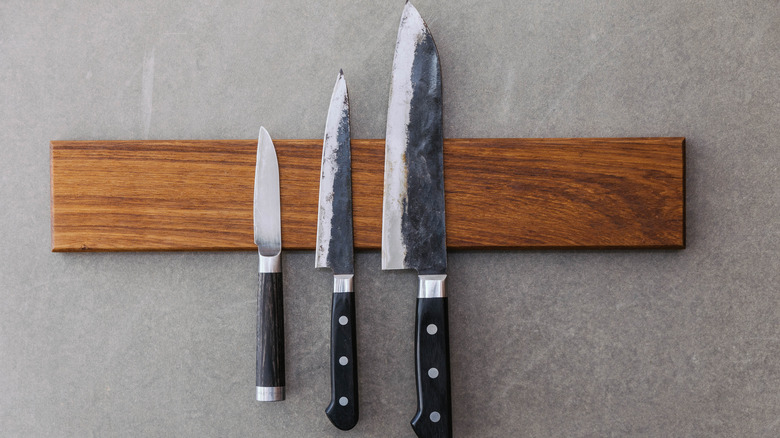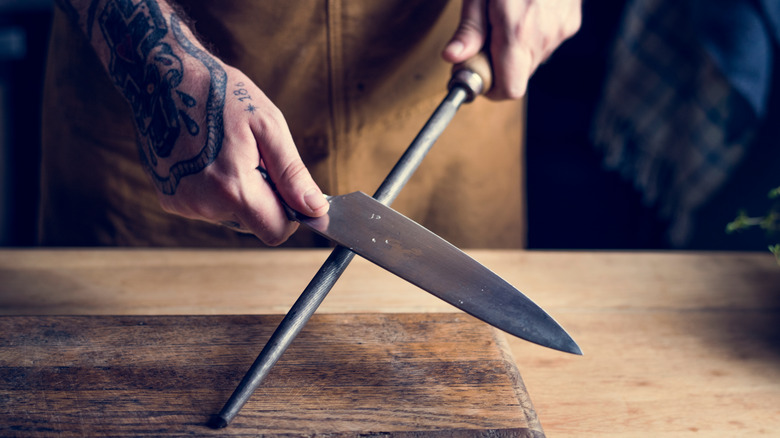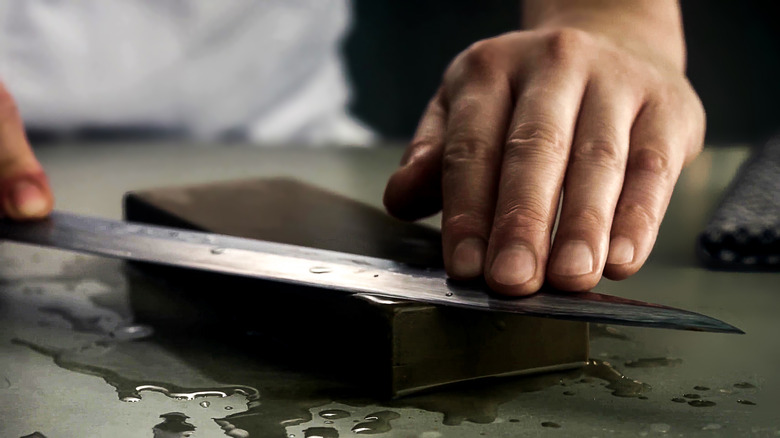Sharpening Vs. Honing A Knife: What You Need To Know
Thinking back on all the different types of meals you cook, how many of them require chopping, deseeding, or trimming? Knives don't get enough credit in the kitchen even though they're probably the item home cooks use most of all. Perhaps it's because a good set of knives can cost a pretty penny. While some may take umbrage with this, TheRecipesPK notes that investing in a proper set of knives is key. High-quality kitchen knives are durable and cut down on the amount of time (and energy) you spend peeling, slicing, carving, or chopping. They're more effective at their job than any cheaper knife would be.
Just like any other investment, you need to take care of the product to keep it in tip-top shape. With knives, this means sharpening and honing. The good news is good quality knives don't require much maintenance, and learning how to sharpen and hone correctly can easily lengthen the lifespan of your kitchen knives.
It's important to understand when your knives need sharpening and when they need honing. Simply put, sharpening removes material, while honing physically centers the edge of the knife (via AllRecipes). Though that's the biggest difference between the two, there's still more you need to learn before you go out and purchase a sharpening stone.
What's the difference between sharpening and honing?
As AllRecipes explains, sharpening and honing are both practices that help keep a knife "sharp and effective." Let's start with honing, which helps a knife maintain its sharp edge by pushing the "edge of the blade back into alignment." This is more of a routine maintenance; doing it regularly can help prevent you from having to replace your knives often, and also lessens the need for frequent sharpening.
Then there's sharpening, which actually removes dull material from the blade and results in a new, much sharper edge. Sharpening is usually only done after trying other knife maintenance options, meaning you've already honed the knife and it still feels and looks dull. Think of sharpening a knife like peeling off a strip of used tape on a lint roller: it's not sticky anymore, so in order to be able to use the roller again, you need to remove the used layer. Sharpening is not something you do frequently.
How do you know when a knife is dull?
A clear-cut way to tell if your knife is dull is if you notice it's taking you twice as long to cut through ingredients, especially meats. Another way you can tell is by simply looking at and feeling it. If the knife blade feels soft (dull) or rounded, then it needs to be sharpened, per The Kitchn. Likewise, if you see that the knife has lost its "teeth," aka the sharper grooves embedded into the blade of the knife, it is most likely a sign that the blade is misaligned or bent, according to AllRecipes. This is a common issue, and it means your knife needs honing.
If you don't want to directly touch a sharp blade, there are three other tests you can do to see if your knife blade is dull. The first, The Kitchn explains, is by slicing through an upright piece of white printer or magazine paper starting at the top of the page. If the knife is able to cut straight down the middle, then it's sharp. Next, try slicing a tomato and onion. Sharp knives will gently slice through both without force whereas dull knives will slide off, smash the produce, or get caught mid-slice.
How often should you be sharpening your knives?
As mentioned above, honing is a technique done frequently to preserve a sharp blade, while sharpening a knife is a technique needed when your knife is at its dullest point and there's no salvaging it, per AllRecipes. Kitchen Knife Planet recommends honing a knife after every three uses. So, if you cut meat, chop veggies, then slice a lime for a cocktail, it's now time to hone. It should go without saying, but be sure to thoroughly wash knives in between every use, too. Kitchen Knife Planet assures that there's no such thing as honing a knife too frequently; however, it does warn that honing a knife for too long "during each session" can be problematic.
Professional sharpening service HoweSharp suggests that sharpening a knife should be done about one to two times a year, provided you've kept up on your honing. To get the sharpest blade possible, you may choose to get your knives professionally sharpened, though it can also be done at home.
What is the best way to sharpen and hone a knife?
Honing can (and should) be done throughout the week, but it can be easily overdone. HoweSharp warns that over-honing a knife can put the knife at "risk of folding the teeth of the blade over too far." To avoid this, the professional sharpening company advises to only hone each side of the knife six times. This should be enough to put the blade's teeth back into alignment. To hone a knife, you'll need a honing steel, which resembles a long screwdriver with a soft pointed edge. At a 15 to 20 degree angle, hone the knife against the steel. Be careful — honing at a higher angle can permanently damage the blade.
When it comes to sharpening knives, many recommend leaving it up to the professionals. AllRecipes reports that folks who want to sharpen knives at home should stick to a sharpening stone over electric sharpeners, which can be too "harsh." Similar to honing, you want to angle the edge of a blade at 20 degrees against the sharpening stone. Then, carefully, apply pressure and "guide the blade across the stone from the heel to the tip." Do this five times. If the knife is still dull, repeat five more times.
When should you hone vs when should you sharpen?
By now, the difference between honing and sharpening a knife has probably been drilled into your brain. That being said, let's get into when you should hone verses when you should sharpen your knives' blades. Honing, at its core, is there to keep the blade aligned. Similar to how you prepare your veggies for eating or cooking by washing, chopping, or peeling them, you prepare your knife for slicing by keeping it honed.
You should sharpen your knife when you see irregularities or dents in the blade or if your knife has a broken tip. You should also sharpen your knife if it's still tough to cut through food, even after honing. Honing is like tuning up your car; it helps the blade cut better and smoother. Sharpening, on the other hand, is like giving your car a brand new engine or battery. Your knife now has a new lease on life. It's practically brand new.
